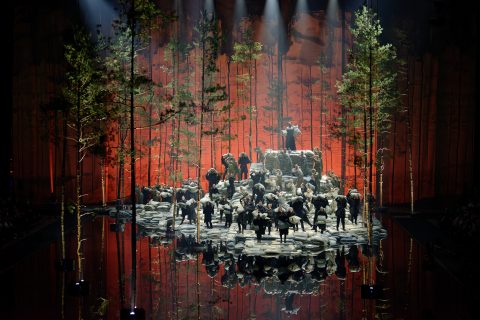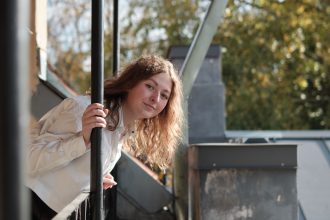When you hear the word “resort”, your thoughts immediately wander to the sandy pine forests, the sunny seashore, alleys full of careless tanned people, and, of course, vacation. Meanwhile, the term “monograph” is usually associated with work and long evenings spent in a library corner.
Architectural historian Viltė Migonytė-Petrulienė virtuosically combined these seemingly unrelated contexts and at the end of the year published her first monograph on resorts Weekendų miestai ir priemiesčiai. Kaip buvo kuriami modernūs kurortai tarpukario (1918–1940) Lietuvoje (Towns and Suburbs of the Weekends. The Development of Modern Resorts in the Interwar Period (1918–1940) Lithuania). Viltė is also the curator of the architectural and heritage program Modernism for the Future, which is part of the Kaunas – European Capital of Culture 2022.

Congratulations on publishing the monograph! Your main scholarly interests are the history of the 20th-century architecture and resort studies. You have defended your doctoral dissertation on interwar period architecture, you have also contributed to preparing the routes of resort guides, which means that you are researching this topic consistently. Tell us, when did you become interested in architecture and one of its branches: resorts?
I am glad that during the preparation of the monograph I had the opportunity to work with a professional team of reviewers (Marija Drėmaitė, Rasutė Žukienė, Vasilijus Safronovas) and the publishing house Lapas.
My curiosity and attentiveness to recreational architecture were inspired by Druskininkai. Although this city has always been a second home to me rather than a resort, I have had the opportunity to observe a radically changing environment. I remember what a wonderful panorama of Druskininkai opened from the roof of the Nemunas Sanatorium and how holidaymakers gathered in a pine forest near the cinema. Later I saw them enjoying ice-ream from graceful metal cups. Very soon after, I with some friends, wandered into abandoned sanatoriums searching for treasure. We were crying out and chasing the echo in the courtyards of former physiotherapy spas. The franchise boom began in the second decade of independence, changing the face of the city beyond recognition in several stages. The waterslide plaits emerged in place of the elegant postmodernist spa tower; more shiny and ornate facades appeared in the Old Town with the Snow Arena reminiscent of Star Wars’ machines on the horizon.
A more serious interest in resort architecture arose during the first year of my undergraduate art history studies. I always knew that my focus will be on architecture, and having witnessed the rapid change in Druskininkai, I could not come up with a more suitable research subject. So, I took a deeper look at the modern resort transformations. This is how another topic – the relationship between the new and the old city – came about. As you know, Druskininkai flourished in the beginning of the 20th century, so the architecture of the romantic villas was asking for someone to look for connections and raised more and more questions: why the architecture of the buildings for vacationers was the way it was; what led to the prevalence of this charming decorative style? Do the shapes of the buildings of the different resorts have similarities, and if they differ, then why? Were the resorts intended solely for recreation? What else was there? I tried to find answers to these and many other questions in my dissertation, but it was not possible to discuss the different functional types of summer places without being aware of the cultural and social issues of the time. This is how I arrived at a very broad and extremely informative topic of Lithuanian resort architecture in the interwar period.
In your monograph, Lithuanian interwar period resorts are explored not only from an architectural but also from a historical and social point of view. What aspirations of the newly formed state can be observed when exploring resorts? How relevant is this topic today?
Here it is important to note one of the main goals of the restoration of Lithuanian resorts, even before the adoption of the Law on Lithuanian Resorts and the significant expansion of the concept of the resort in the 1930s. After the First World War, in addition to rebuilding the necessary infrastructure, solutions to other social welfare issues were sought. With the increase in the number of settlers in the cities during the interwar period, the threat of an exacerbation of the diseases that plagued the Lithuanian population at that time arose, therefore the health of the Lithuanian population was a primary concern. In the first decade of the interwar period, it was decided to direct the flow of patients at the national level to two resorts famous for their mineral waters: Birštonas and, a little later, Likėnai. Of course, given the ambitions of the difficult first decade of independence, it was equally important to promote the economic potential of society. The story of the restoration of entertainment content in Palanga could be a very good example in this context when it was decided in 1921 to follow the vision of a “European-level resort”.
Looking at the short history of interwar resorts in general, the idea itself reflects the search for a new model of life that can help ensure social stability. Could we find similar aspirations in the programs of resort developers today? It is not that easy to define what kind of stability we should talk about. Perhaps the economic one.

You mentioned that the title of the book Weekendų miestai is a direct quote from specialized publications. The Western elements that were especially popular in the interwar period, playfully reveal the main task of the resort – to present the utopia of modern and free life. What measures were taken to impress and attract holidaymakers? Were they effective?
Through the media sources of the time, especially the specialized press that focused on reviewing resorts. Advertising of Western products (chocolates, whiskey, cigars, swimwear, beauty and hygiene products, etc.) played an important role here. Secondly, with certain forms of activity and their variety, which enriched the summer life of holidaymakers, recreational content was combined with rehabilitation treatment services. It is probable that it was efficient and profitable because even the towns and suburbs that were not officially recognized as such, for example, Kazlų Rūda, Viekšniai, Jurbarkas, Pasvalys referred to themselves as such.
Can we grasp the holiday habits that were formed in the interwar period today?
I believe so. In less than two decades, the resort environment has changed dramatically. We can certainly see many signs of these changes today, especially the freer culture of leisure. In the 1920s, we could have only dreamt about common bathing and those who decided to do so together had to pay a substantial fine. But then after five years, no one talked about such restrictions anymore, even the nudist sunbathing became quite common. Another well-recognized resort phenomenon is year-round recreation. It was possible to stay in sanatoriums or villas built in the 1930s in the cold season as well. The buildings were heated and the dynamic entertainment at the holiday homes extended the guests’ stays. I believe that the so-called “pillow fee”, which is well known to many, has been collected in many Lithuanian resorts since the early 1930s, and in some places even earlier.

Kaunas, the modern capital of that time, paid a lot of attention to leisure culture. In the book, you write that a part of the city was declared a resort with 12 beaches, and recreational settlements were formed around Kaunas (Kačerginė, Kulautuva, etc.). Were the resorts of Kaunas and its surroundings in any way unique – due to the high concentration of the population and the increased demand – in the context of interwar period Lithuania?
In the interwar period, the so-called pakaunė resorts were not only administratively, but also ideologically in the urban area of influence of the capital at that time, so urban forms of lifestyle were most prevalent in them. I would say that this is what makes them unique. And, although the idea of a “satellite city” typical of modernity has not been directly developed in the mentioned resorts, the features of this principle can be seen very clearly, for example, in Aukštoji Panemunė. The penetration of the urban culture and modern construction traditions into the more remote resort areas of Kaunas can be observed in the territorial expansion possibilities presented in the Law on Urban Construction prepared in 1939. Based on it, the establishment or expansion of existing cities and towns was allowed even in factory districts or near large transport stations. Much more imposing residential buildings, which combine the influence of modern thought of the capital with the expression of local resort architecture, started emerging in these resorts during a similar time.

I would like to conclude the interview with the way you begin your book. At the beginning of the monograph, you quote Paul Valery, “Tell me, since you are so sensitive to the effects of architecture, have you not noticed, when walking around the city, how some of the buildings that populate it are silent, and others speak, while others still, the rarer ones, sing?” Which buildings, what architecture sings to you?
First of all, of course, the architecture of resorts because it is personal. While exploring it further, it truly sang to me, though obviously, I haven’t heard everything yet. I hope to continue this interesting musical/architectural journey in the future. I am also convinced that Kaunas modernism has its own jazz melody. The quality of its interpretations greatly depends and will continue to depend for a long time on how capable we will be and whether we will want to stretch our strings, adjust the keyboards and lubricate the wind instruments to discover the best-sounding melodies. For now, and for the future.




